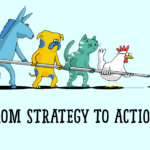Denkplan © – Values and principles behind Denkplan
The success of any idea owns as fundament a mental model. Therefore we are happy to talk about the core elements of the mental model behind Denkplan.
The agile and lean community lives a widely agreed mental model. This mental model starts from the needs of a person or organization and drills down to concrete techniques and tools that support specific actions. The spine model of well-known drivers in the community describes this mental model as following (citation from https://spinemodel.info/explanation/introduction/)
“Once you understand the reason [the human work] system exists in the first place, and the reason you want to be a part of the system (Needs), you can decide what to optimize for (Values). Once you have decided what you are optimizing for, you can decide what ecological levers are going to get you there (Principles). Once you have that, then decide how you are going to do it (Practices). And once you have done that, decide if any refinement is needed (Tools).”

Denkplan is based on Agile & Lean values
Denkplan is based on this mental model and focusses on the following values and principles
- Transparency
- Conversation and feedback culture
- Cadence and synchronization
- Value based prioritization
- Focus
- A smart combination of physical and electronic instruments
Transparency
Transparency is an often used and abused term. I recommend a test: as normal average employee, go and ask for the full and complete version of the current strategy presentation. I guess in many companies the answer will be: confidential. This is just weird. How can management expect that every employee is motivated to realize an unknown strategy?
Transparency is a core value in Denkplan. Transparency includes every single person working in the organization. Strategy must have a vivid and visual representation. It shall be easy to understand. A visual representation and physical instruments to work with motivate to start conversations fostering feedback and driving strategy evolution. Ideal everybody may participate, but do not expect everybody to participate.
Conversation and feedback culture
Denkplan is not e receipt. Denkplan is an approach that requires a healthy base and adoption to succeed. Denkplan is based on agile and lean values and principles. Conversation and a feedback culture are core agile values for the optimal adoption of the Denkplan concepts. Non-agile environments will benefit from these concepts as well, but the full potential most probably will stay undiscovered. By the way, that is my experience for many agile instruments applied in non-agile organization. Without an agile mindset behind you may end up disappointed and say the instrument failed. Like taking a knife by the blade and blaming the knife.
There is a new chance in Denkplan. In many organizations that introduced agility in some way, still the top management and parts of the so called business stick the previous values and way of doing things. This could be a disaster because two different mental models potentially clash. That’s full of risks. Denkplan offers the potential to integrate management and business in the agile mental model in a way they like and want to be part of it. At least this is our experience in many experiments.
Cadence and synchronization
Classical project leads, and manager often say agile and lean systems would be chaotic and change direction and goals from day to day. That is nonsense. Agile working is well structures and disciplined. Scrum for example recommends a very strict meeting culture called events. Every event has a very specific focus, agenda and content. Every event has its strict cadence and length. This is discipline.
Just as a side statement: My personal observation is that agile is hard for many individuals right because it demands a sound level of self-discipline and commitment. And, to be frank: We as human beings do have our problems with self-discipline and commitment from time to time – especially if we are under stress.
Denkplan leads the discipline as in Scrum to the level of the whole organization. Around the instruments and elements of Denkplan (Scrum would say the artifacts) we recommend establishing an event culture with a fixed cadence, with well-defined participants, a focus agenda and clear goals what to achieve. This discipline fosters conversations and feedback while being efficient. In general, such a meeting culture is an efficient replacement of many unstructured ad-hoc meetings with unclear goals, too many attendees and no goals defined – but this is out-of-scope of this blog series. Let’s stay focused…
Value based prioritization on all levels
The problem of many companies leading strategy to action is prioritization. Most companies decide to push just every single idea listed in the strategy as project into the portfolio – at least the ones of the most influencing management members. Background are political reasons to make every strong influencer on or just below C-Level at least a bit happy. These persons are as well the project sponsors deciding about budget. That’s important as the next step following is defining budget posts for every portfolio item for the next twelve months to express at least some kind of importance. The budget game is time consuming and – worse – leads to a peer competition within the organization. Wouldn’t it be better everybody pulling in the direction of an agreed strategy? And the result of this budget battle – large projects win, small projects tend to starve to death, although a small project could result in a tremendous gain.
Denkplan plays another game. There are no “projects” in the classical way. In fact we avoid the term project at all. Instead the evolution of the company uses a portfolio of (ideally) equal sized (we call them) initiatives driven by strategic themes. Smart business goals define the development of a strategic theme (we actually use the canvas technique) and its evolution over time. An initiative is a single evolution step in a theme with a short lead time, creating a well-defined and measured business value. In this way the company collects fast feedback often about successful and failing initiatives. This offers the chance to explore and learn about the market and customers. Prioritization of upcoming initiatives is based on this learning what creates values. This is what we treat a business value based prioritization on a roadmap level. We treat this as the most abstract action level below the strategy. It is on level tactical implementation of he strategy
By the way, Jeff Patton created a wonderful and very powerful instrument to work visual with value based prioritization – the concept of the story map. We applied and adopted Jeff’s idea of story mapping on company level as a key element in Denkplan.
Focus
A popular discussion in many companies is how to shorten lead time. Problem is that a company wants everything, and that asap.
Just as intermezzo: the other popular question is about cost savings. Sorry, but for the me and many other lean thinking individuals the cost saving question is the wrong question. A company has its investment budget. That’s a fact. A company can spent the budget in form of cash out or for salaries (all the other tiny details like activating capex costs are CFO tricks to save taxes – fine, we can accomplish this in agile as well). Lean individuals strive to create always maximum business value with this investment power, no matter of what type business value is. Cost saving actions might be part of it (automation, digitalization), yet creating (scaling and invoiced) customer delight is the cream on the cake – isn’t it? Cost saving does not scale. It is quick win with long term loss. End of intermezzo.
Let’s return to the “shorten lead time” discussion. When asked – out of the blue not knowing much about a company – my answer is: Most probably you shorten lead time by stopping fifty percent of your projects NOW, especially the grinding ones. All the other projects then will speed up tremendous and – funny – you will not perceive a significant drawback.
Queueing theory tells us that already since decades, even before agile. Don Reinersten wrote a book about this. Nearly everybody agrees and only few organizations act like this: one piece flow. Reinersten lists good practices in his book supporting this: minimize cost of delay, minimize batch size, minimize variation in batch item size, shorten queues (ideally down to one). Denkplan integrates these good practices.
The smart combination of physical and electronic instruments
Agility is a lot around conversation. Conversation is established in events (meetings) that follow a cadence and synchronize the information and feedback flow in the organization. Conversation requires instruments that foster conversation leading to a common agreed vision, to decisions and consensus. On the other hand, there is a lot of additional information “hooked” to the instruments used in the conversations. A good example is Scrum and the card-conversation-confirmation practice, called CCC. The card is the hook. And, for example in Jira (or – worse – PowerPoint presentations), many additional and valuable information is hooked to that card in the tools, like a business case (better: a canvas), a customer journey, acceptance criteria, interface mockups, drawings, whatever.

Physical and electronic instruments complement each other
We discovered that physical and electronic means complement for tremendous benefit if combined in a smart way. We already use this principle in many places like DevOps. We experimented quite a lot in real cases to identify the basic concept of smart combination and identified a blueprint. This blueprint needs to be adopted and implemented in the ecosystem of the target organization. This includes establishing an event (meeting) and decision culture driven by valuable conversations.
Ok, that blog about values and principles behind does not yet present the methodology of Denkplan. Nevertheless, I feel better If you understand the mental model behind that drives the methodology. I promise, in my next blog you will get the overview over the instruments followed by blogs that dive into details of every single instrument; its usage; and the options to adopt it aligned to your company’s needs.
In many life cases we recognized that very simple physical instruments like a large wall with post-its is a perfect start. Most companies moved from post-its to a more serious looking yet physical system like Memox cards. The concept of physical walls proofed to be a success. Denkplan uses three basic types of physical walls that are interconnected and play a consistent game AND are complemented by tools like Jira.
Denkplan © and the concepts behind is a registered trademark of DoD!fferent GmbH, Saraes Media GmbH and Juropera GmbH.
 Vorheriger Beitrag
Vorheriger Beitrag Nächster Beitrag
Nächster Beitrag


